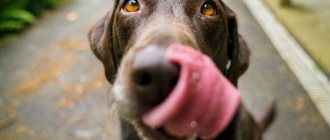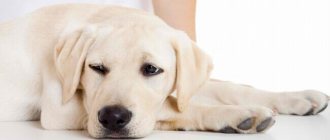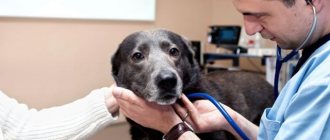Young dogs are often exposed to various injuries due to the fact that they are quite mobile, but their bodies are not yet adapted to significant stress. One of the most common pathologies of this kind is a sprain in a dog’s hind legs. This can happen to any animal, so it is very important to understand the causes of this problem, what symptoms you should pay attention to, and how to treat if the dog is injured. Knowing this information, you can easily restore your pet’s previous life within a few days, even if it was accidentally injured.
Causes of sprains
This is one of the most common injuries that this animal can receive in childhood by overloading its paw. The joint of the limb is designed to protect the bone from various types of damage, covering it with elastic fibrous tissue, and is also responsible for the process of shock absorption when walking or jumping. Stretching causes several of these fibers to break due to sudden overstrain. For an animal, this condition is very painful and unpleasant. It is expressed, among other things, by severe swelling of the paw.
Among the main reasons why a dog develops sprains, veterinarians identify the following:
- Limb injury. The most severe cases may even be accompanied by fractures or dislocations. In such cases, spraining is not the most significant problem.
- Incorrect nutrition. First of all, this concerns a lack of calcium, as well as some other microelements. As a result, elastic tissue loses its functions, which is accompanied by weakness of the ligaments.
- Genetic predisposition. Often, heredity in decorative dogs leads to the fact that they suffer from certain diseases, including abnormalities in the development of the ligamentous apparatus.
- Sudden weight gain. As a result, the animal’s body simply does not have time to fully adapt to the changes that have occurred to its body.
- Excess weight. In this case, the dog, despite its low mobility, can still get a sprain.
- Some types of loads during the active growth phase. First of all, this all concerns climbing to heights or overcoming large obstacles.
Sprained ligaments are a rather unpleasant consequence that can be influenced by all of the above factors. It requires a certain level of care for the pet and changes in its lifestyle. In any case, it is worth giving up regular workouts for a while.
What is a cruciate ligament?
Even a superficial knowledge of the biomechanics of a dog’s knee joint is already the basis for understanding what a cruciate ligament is and why it tears.
The name “cruciform” means “to cross,” “to form a cross,” or “shaped like a cross.” The ligaments attach to the femur and tibia at the top and bottom of the knee joint.
Anatomy of the dog's knee joint
A dog has two cruciate (cruciate) ligaments - the anterior (ACL - cruciate ligament rupture in dogs) and the posterior (PCL). Essentially, these are two strips of fibrous tissue - bundles of collagen fibers that perform opposite functions.
Always working in pairs and distributing the load between themselves, they are the main stabilizing component of the knee joint during flexion and extension. The more the knee joint is extended, the greater the load on the anterior cruciate ligament. When the knee bends more than 90°, the entire load gradually transfers to the back.
The main function of the cruciate ligament is to prevent excessive stretching, so it is constantly subject to tensile loads.
Both ligaments are mega strong - it’s extremely difficult to break them just like that. Sometimes during an injury the ligament does not tear, but comes off with a fragment of the leg bone (avulsion). This suggests that an initially healthy ligament is stronger than bone.
Both ligaments are located slightly obliquely, due to which they perform the following functions:
- The posterior cruciate ligament prevents the tibia from excessively externally rotating and moving backward. That is, the PCL limits external rotation and prevents caudal displacement of the tibia.
- The anterior cruciate ligament prevents the tibia from excessively rotating inward and moving forward. That is, the ACL limits internal rotation and prevents cranial displacement of the tibia. It also prevents hyperextension of the knee joint, which is very important. When a dog already has a tendency to hyperextend, an ACL injury is more likely.
Since the anterior cruciate ligament performs more functions and is constantly tense, it is the one that is most often injured
Anterior cruciate ligament rupture video
How and why does a dog's anterior cruciate ligament get damaged?
The knee joint is a complex joint consisting of the connection of three bones. It is very unstable because there is no blockage of the bones in the joint. This spherical mechanism is stabilized only by the large ligamentous apparatus. Cruciate ligaments limit excessive joint mobility during movement and rest.
Unfortunately, biomechanical imbalances often occur in dogs - these are forces acting on the knee joint that, during movement, increase stress on the anterior cruciate ligament. The acting forces are active (muscles) and passive (plateau tilt, weight, posture, etc.).
Biomechanical imbalances continually place stress on the cruciate ligaments. This leads to chronic stress (overload) of the ligaments, which subsequently causes degenerative changes, the outcome of which is tear and complete rupture of the anterior cruciate ligament.
Biomechanical imbalance in the knee joint
Immediately after a rupture of the anterior cruciate ligament, instability occurs in the knee joint - during each step, the lower leg moves towards the front of the body. This leads to pain, lameness and damage to the meniscus (usually the medial one), which further aggravates the problem. To learn more about menisci, click here.
If you notice any gait disturbance in your dog, be sure to visit a veterinarian orthopedic traumatologist
MAKE AN APPOINTMENT FOR YOUR PET WITH A DOCTOR
Symptoms of injury
The symptoms of sprains are quite characteristic and easily recognizable. This is due to the fact that after an injury and rupture, an inflammatory process begins in the limb. Depending on its severity, veterinarians distinguish three stages:
- Easy. The dog feels only slight pain, since several fibers have been torn, and the rest are intact.
- Average. In this case, the gap is more significant and serious. It still preserves the overall integrity of the paw joint.
- Heavy. This case is considered the most unfavorable. It characterizes a complete rupture of the ligaments. Often this pathology occurs against the background of fractures and dislocations. That is why veterinarians classify it as a separate type of limb injury.
If we talk about signs and symptoms, then it is definitely worth highlighting the following complex:
- Lameness. The animal tries very carefully to stand on the damaged paw.
- Swelling of the paw tissue. Swelling can be seen at the site where the damage occurred.
- Painful sensations. The dog pulls out its paw when examined.
- A certain position of the limb. Most often, the animal will hold it in a half-bent, suspended position. This is due to the fact that the dog will be afraid of the pain that he can get from leaning on his paw. In some cases, if the gap is significant, you can even determine by touch where it occurred.
- Increased body temperature. This only applies to the site of the inflammatory process.
- Skin damage. This happens when you get injured.
- Hematoma formation. This rarely happens when blood vessels are affected. If your dog has one or more of the above symptoms, you should contact your veterinarian.
Anatomy
Figure 1 shows the structure of the carpal joint and Figure 2 of the tarsal joint: they consist of multi-level joints with a number of auxiliary ligaments and a joint capsule.
The wrist consists of three joints: the antebrachiocarpal joint, the midcarpal joint, and the carpometacarpal joint. The main range of motion of the wrist (70%) occurs at the antebrachiocarpal joint, while the midcarpal and carpometacarpal joints have a minimal range of motion. A thick cushion of fibrocartilage (fibrocartilage) on the underside of the joint separates the carpal and metacarpal bones. The major accessory ligaments of the wrist include the medial (radial) and lateral (ulnocarpal) collateral ligaments, which support each side of the joint, as well as numerous dorsal (upper) and palmar (lower) ligaments.
Likewise, the tarsal joint is complex and consists of four joints: the tibiotarsal joint, the proximal (upper) intertarsal joint, the distal (lower) intertarsal joint, and the tarsometatarsal joint. The main range of motion of the tarsus (80%) comes from the tibiotarsal joint. The tarsal joint is supported by numerous ligaments, including the medial and lateral collateral ligaments, dorsal (upper) and plantar (lower) ligaments.
Treatment of pathology
Treatment for sprains in dogs can be of two types: first aid and comprehensive primary therapy. If the pathology is mild or moderate, then the dog can remain at home. The most serious injury requires appropriate surgical intervention by doctors. In most cases, the hind legs are affected. This is due to the fact that they bear the largest share of loads, both when running and when jumping.
As first aid, it is worth determining the following sequence of actions:
- It is necessary to apply an ice pack to the place where the ligament was torn. This can help reduce swelling and the inflammatory process itself. In this way, new complications such as high fever or the development of hematoma can be prevented.
- After 15-20 minutes, you can remove the ice from the paw. A fairly tight bandage should be applied to it, thereby fixing the limb. This is necessary so that the dog cannot accidentally aggravate the existing damage.
- If your dog continues to experience severe pain and cannot find a place to rest, you should definitely see a veterinarian. This may indicate that the injury is serious and requires specialist intervention.
- Under no circumstances should you give your pet painkillers. This can significantly worsen the situation. When the dog stops feeling discomfort, it begins to lean on the sore leg, thereby continuing to tear the weak elastic fibers.
Treatment requires quite a long time, so every owner of his pet should understand how to carry out therapy in the following days after the animal’s condition has been relatively stabilized.
On the second day after a sprain, you should apply alcohol compresses to your leg. They help improve blood circulation and warming.
On the third day after the sprain, you can begin to lightly massage the paw. Thermal wraps and paraffin applications will also be useful.
On the fourth day after the injury, you can start using ointments and gels based on troxevasin. This greatly promotes healing. First of all, it is worth highlighting such drugs as Phytoelita and Hydrocortisone.
Attention! In the first few days after a sprain has occurred, it is worth very carefully monitoring the animal’s health. It is necessary to pay attention to the temperature of his body, as well as directly to the site of injury. If an abscess appears, this may indicate that the wound has become infected. Subsequently, the dog will have to be treated for this infection.
In most cases, a pathology such as sprained ligaments in dogs goes away within 3-5 days, if there are no additional problems or complications. When they are present, therapy can take a longer period.
Therapeutic treatment of ligament rupture in dogs
Treatment involves a number of therapeutic and health measures: anti-inflammatory therapy, restriction of the pet’s mobility and the use of special dog knee pads.
Anti-inflammatory therapy
If a cruciate ligament rupture is diagnosed, anti-inflammatory drugs are prescribed to relieve inflammation and reduce pain in the knee joint. The course of treatment and dosage are determined taking into account the weight of the animal and the course of the disease. For example, young dogs weighing up to 5 kg are prescribed Loxicom in suspension for up to 10 days (the dosage depends on the specific weight). For large pets, take Rimadyl or Previcox in tablet form.
It is not recommended to offer non-steroidal anti-inflammatory drugs to an animal without the advice of a veterinarian. Their incorrect use leads in most cases to severe irritation of the mucous membrane of the intestines and stomach, and in case of overdose and frequent use - to ulcers and erosions. Use medications only as prescribed by your veterinarian.
Limiting your pet's movements for up to 1 month
If the knee ligament is torn, it will be necessary to take strict measures to limit the movement of the pet. In case of a partial break, walking on a short leash for short distances is allowed. If the ligament is completely torn, the sick pet is kept in a small enclosure to avoid increased activity. The dog is strictly forbidden to make sudden movements, jumps, and even more so, forget about active games for a while.
Using knee pads for pets
This measure is effective only in complex therapy. Properly fixed therapeutic knee pads allow you to provide additional support to the joint during active activities and movements of your pet. It is important to remember that improper fixation can lead to deformation of the knee joint and the development of pathological conditions. Therefore, it is so important to entrust this procedure to professional veterinarians.
Signs
The first symptoms of a dislocated paw in a dog are lameness or an unnatural posture. Other signs depend on the location of the damage:
- when a pet cannot stand up normally and has difficulty lying down, this indicates a sprain or dislocation of the dog’s hind leg;
- with a hip sprain, the animal’s paw is tucked in, but is in a natural position, and when this joint is dislocated, the tucked paw “falls” inward and it is also difficult for the animal to get up after lying for a long time;
- with medial dislocation of the patella, the joint moves inward or outward and swells, the animal has difficulty moving the limb and tries to direct it inward;
- a dislocated shoulder is expressed by a displacement of the scapula and lameness, while the pet falls over when walking, so it is difficult to understand which paw hurts;
- When a dog’s front paw is sprained or dislocated, the symptoms of lameness are complemented by a “staggering” gait with tucking of the affected limb.
Each touch to a dislocated joint causes severe pain. Because of this, the dog may show aggression, growl, whine and try to run away.
First aid
If your dog shows symptoms of a dislocation, you should not panic, since the injury, although serious, is not life-threatening if treated in a timely manner. The main thing is to provide first aid correctly and immediately call a veterinarian or take the animal to the clinic.
First of all, you need to put a muzzle on your pet, since any dog in pain shock can become aggressive and unpredictable. Then the algorithm of actions should be as follows:
- carefully lay the pet down with the damaged joint facing up and inspect for tissue tears;
- do not allow him to walk, but, if necessary, carry him on a stretcher or blanket;
- fix the joint with an elastic bandage, ideally with the application of a soft splint with fastening above and below the joint;
- wrap the injured area with film, then with cloth and apply cold.
You can’t straighten a dog’s dislocated paw yourself! Improper actions can cause significant harm and cause severe pain to the animal, especially if the injury is accompanied by ligament rupture and internal bleeding.
Before contacting a veterinarian, it is necessary to monitor the temperature of the limb with a fixing bandage. If she gets cold, then the bandage should be loosened.
In case of severe pain syndrome, in which the animal whines or howls, it is recommended to inject an anesthetic drug. Such traditional “human” analgesics as Ketanov, Baralgin or Analgin are suitable for this. If your pet is allergic to such medications, only zoo medications, in particular Travmatin, can be injected.
Prevention
Although wrist and tarsal injuries can occur due to constant activity and occasional sprains, most of these injuries occur outside the ring. Jumping from a height is one of the most common causes of severe injuries. Therefore, such actions should be avoided whenever possible. Agility dogs with chronic carpal and tarsal injuries may benefit from wearing regular support cuffs (bandages) during training or competition.
Clean Run magazine











